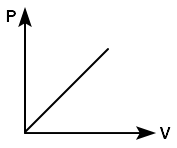When the sink temperature is kept at 400 K, the efficiency of a Carnot engine is 50%. While keeping the source temperature constant, by how much should we reduce the sink temperature to increase the efficiency to 60%?
1.
80 K
2.
70 K
3.
320 K
4.
240 K

To unlock all the explanations of this course, you need to be enrolled.

To unlock all the explanations of this course, you need to be enrolled.
Which of the following graph shows the variation of pressure P with volume V for an ideal gas at a constant temperature?
| 1. |  |
2. |  |
| 3. |  |
4. |  |

To unlock all the explanations of this course, you need to be enrolled.

To unlock all the explanations of this course, you need to be enrolled.
A gas performs the minimum work when it expands:
| 1. | Isochorically | 2. | Isobarically |
| 3. | Adiabatically | 4. | Isothermally |

To unlock all the explanations of this course, you need to be enrolled.

To unlock all the explanations of this course, you need to be enrolled.
An ideal gas goes from \(A\) to \(B\) via two processes, \(\mathrm{I}\) and \(\mathrm{II},\) as shown. If \(\Delta U_1\) and \(\Delta U_2\) are the changes in internal energies in processes \(\mathrm{I}\) and \(\mathrm{II},\) respectively, (\(P:\) pressure, \(V:\) volume) then:

| 1. | \(∆U_1 > ∆U_2\) | 2. | \(∆U_1 < ∆U_2\) |
| 3. | \(∆U_1 = ∆U_2\) | 4. | \(∆U_1 \leq ∆U_2\) |

To unlock all the explanations of this course, you need to be enrolled.

To unlock all the explanations of this course, you need to be enrolled.
An ideal monoatomic gas \(\left(\gamma = \frac{5}{3}\right )\) absorbs 50 cal in an isochoric process. The increase in internal energy of the gas is:
| 1. | 20 cal | 2. | Zero |
| 3. | 50 cal | 4. | 30 cal |

To unlock all the explanations of this course, you need to be enrolled.

To unlock all the explanations of this course, you need to be enrolled.
The pressure-temperature \((P\text-T)\) graph for two processes, \(A\) and \(B,\) in a system is shown in the figure. If \(W_1\) and \(W_2\) are work done by the gas in process \(A\) and \(B\) respectively, then:

| 1. | \(W_{1}=W_2\) | 2. | \(W_{1}<W_2\) |
| 3. | \(W_{1}>W_2\) | 4. | \(W_{1}= - W_2\) |

To unlock all the explanations of this course, you need to be enrolled.

To unlock all the explanations of this course, you need to be enrolled.
The variation of molar heat capacity at constant volume with temperature T for a monatomic gas is:
| 1. |  |
2. |  |
| 3. |  |
4. |  |

To unlock all the explanations of this course, you need to be enrolled.

To unlock all the explanations of this course, you need to be enrolled.
When a system is moved from state \(a\) to state \(b\) along the path \(acb\), it is discovered that the system absorbs \(200~\text{J}\) of heat and performs \(80~\text{J}\) of work. Along the path \(adb\), heat absorbed \(Q =144~\text{J}\). The work done along the path \(adb\) is:

| 1. | \(6~\text{J}\) | 2. | \(12~\text{J}\) |
| 3. | \(18~\text{J}\) | 4. | \(24~\text{J}\) |

To unlock all the explanations of this course, you need to be enrolled.

To unlock all the explanations of this course, you need to be enrolled.
If a refrigerator extracts heat 'a' from the cold reservoir and 'b' is the heat released from the hot reservoir, then the work done on the refrigerant (system) is:
1. a + b
2.
3. a
4.

To unlock all the explanations of this course, you need to be enrolled.

To unlock all the explanations of this course, you need to be enrolled.
1. \(5:3\)
2. \(5:2\)
3. \(1:1\)
4. \(5:7\)

To unlock all the explanations of this course, you need to be enrolled.

To unlock all the explanations of this course, you need to be enrolled.




